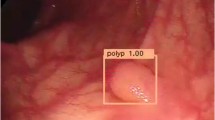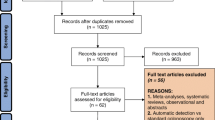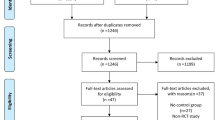Abstract
Purpose of Review
Artificial intelligence (AI) is a rapidly growing field in gastrointestinal endoscopy, and its potential applications are virtually endless, with studies demonstrating use of AI for early gastric cancer, inflammatory bowel disease, Barrett’s esophagus, capsule endoscopy, as well as other areas in gastroenterology. Much of the early studies and applications of AI in gastroenterology have revolved around colonoscopy, particularly with regards to real-time polyp detection and characterization. This review will cover much of the existing data on computer-aided detection (CADe), computer-aided diagnosis (CADx), and briefly discuss some other interesting applications of AI for colonoscopy, while also considering some of the challenges and limitations that exist around the use of AI for colonoscopy.
Recent Findings
Multiple randomized controlled trials have now been published which show a statistically significant improvement when using AI to improve adenoma detection and reduce adenoma miss rates during colonoscopy. There is also a growing pool of literature showing that AI can be helpful for characterizing/diagnosing colorectal polyps in real time. AI has also shown promise in other areas of colonoscopy, including polyp sizing and automated measurement and monitoring of quality metrics during colonoscopy.
Summary
AI is a promising tool that has the ability to shape the future of gastrointestinal endoscopy, with much of the early data showing significant benefits to use of AI during colonoscopy. However, there remain several challenges that may delay or hamper the widespread use of AI in the field.

Similar content being viewed by others
References
Papers of particular interest, published recently, have been highlighted as: • Of importance •• Of major importance
Kröner PT, Engels MM, Glicksberg BS, Johnson KW, Mzaik O, van Hooft JE, et al. Artificial intelligence in gastroenterology: a state-of-the-art review. World J Gastroenterol. 2021;27:6794–824.
Berre CL, Sandborn WJ, Aridhi S, Devignes M-D, Fournier L, Smaïl-Tabbone M, et al. Application of artificial intelligence to gastroenterology and hepatology. Gastroenterology. 2020;158:76-94.e2 (Elsevier).
Bray F, Ferlay J, Soerjomataram I, Siegel RL, Torre LA, Jemal A. Global cancer statistics 2018: GLOBOCAN estimates of incidence and mortality worldwide for 36 cancers in 185 countries. CA Cancer J Clin. 2018;68:394–424.
Corley DA, Jensen CD, Marks AR, Zhao WK, Lee JK, Doubeni CA, et al. Adenoma detection rate and risk of colorectal cancer and death. N Engl J Med. 2014;370:1298–306 (Massachusetts Medical Society).
Zhao S, Wang S, Pan P, Xia T, Chang X, Yang X, et al. Magnitude, risk factors, and factors associated with adenoma miss rate of tandem colonoscopy: a systematic review and meta-analysis. Gastroenterology. 2019;156:1661-1674.e11 (Elsevier).
le Clercq CMC, Bouwens MWE, Rondagh EJA, Bakker CM, Keulen ETP, de Ridder RJ, et al. Postcolonoscopy colorectal cancers are preventable: a population-based study. Gut. 2014;63:957–63 (BMJ Publishing Group).
Robertson DJ, Lieberman DA, Winawer SJ, Ahnen DJ, Baron JA, Schatzkin A, et al. Colorectal cancers soon after colonoscopy: a pooled multicohort analysis. Gut. 2014;63:949–56 (BMJ Publishing Group).
Aslanian HR, Shieh FK, Chan FW, Ciarleglio MM, Deng Y, Rogart JN, et al. Nurse observation during colonoscopy increases polyp detection: a randomized prospective study. Am J Gastroenterol. 2013;108:166–72.
Maroulis DE, Iakovidis DK, Karkanis SA, Karras DA. CoLD: a versatile detection system for colorectal lesions in endoscopy video-frames. Comput Methods Programs Biomed. 2003;70:151–66.
Iakovidis DK, Maroulis DE, Karkanis SA. An intelligent system for automatic detection of gastrointestinal adenomas in video endoscopy. Comput Biol Med. 2006;36:1084–103.
Urban G, Tripathi P, Alkayali T, Mittal M, Jalali F, Karnes W, et al. Deep learning localizes and identifies polyps in real time with 96% accuracy in screening colonoscopy. Gastroenterology. 2018;155:1069-1078.e8 (Elsevier).
•• Wang P, Berzin TM, Glissen Brown JR, Bharadwaj S, Becq A, Xiao X, et al. Real-time automatic detection system increases colonoscopic polyp and adenoma detection rates: a prospective randomised controlled study. Gut. 2019;68:1813–9. This was the first randomized controlled trial evaluating CADe in colonoscopy, showing a statistically significant benefit with AI.
• Repici A, Badalamenti M, Maselli R, Correale L, Radaelli F, Rondonotti E, et al. Efficacy of real-time computer-aided detection of colorectal neoplasia in a randomized trial. Gastroenterology. 2020;159:512-520.e7. This was the first randomized trial from a western country with high baseline ADR. This study showed a statistically significant increase in ADR in the AI group, despite a high baseline ADR in the control group.
• Glissen Brown JR, Mansour NM, Wang P, Chuchuca MA, Minchenberg SB, Chandnani M, et al. Deep learning computer-aided polyp detection reduces adenoma miss rate: a United States multi-center randomized tandem colonoscopy study (CADeT-CS Trial). Clin Gastroenterol Hepatol. 2022;20:1499-1507.e4. (Elsevier). This was the first randomized controlled trial on CADe from the United States. This study showed lower adenoma miss rate with use of CADe.
• Wallace MB, Sharma P, Bhandari P, East J, Antonelli G, Lorenzetti R, et al. Impact of artificial intelligence on miss rate of colorectal neoplasia. Gastroenterology. 2022;163:295-304.e5. (Elsevier). Important study from the US and Europe that showed that CADe led to a 50% reduction in adenoma miss rate.
Shaukat A, Lichtenstein DR, Somers SC, Chung DC, Perdue DG, Gopal M, et al. Computer-aided detection improves adenomas per colonoscopy for screening and surveillance colonoscopy: a randomized trial. Gastroenterology Elsevier. 2022;163:732–41.
Shah S, Park N, Chehade NEH, Chahine A, Monachese M, Tiritilli A, et al. Effect of computer-aided colonoscopy on adenoma miss rates and polyp detection: a systematic review and meta-analysis. J Gastroenterol Hepatol [Internet]. [cited 2023 Jan 16];n/a. Available from: https://onlinelibrary.wiley.com/doi/abs/10.1111/jgh.16059.
Aziz M, Haghbin H, Sayeh W, Alfatlawi H, Gangwani MK, Sohail AH, et al. Comparison of artificial intelligence with other interventions to improve adenoma detection rate for colonoscopy: a network meta-analysis. J Clin Gastroenterol [Internet]. 2022 [cited 2023 Jan 16];Publish Ahead of Print. Available from: https://journals.lww.com/10.1097/MCG.0000000000001813.
• Wang P, Liu X, Berzin TM, Glissen Brown JR, Liu P, Zhou C, et al. Effect of a deep-learning computer-aided detection system on adenoma detection during colonoscopy (CADe-DB trial): a double-blind randomised study. Lancet Gastroenterol Hepatol. 2020;5:343–51. This is the only double-blind study on CADe using a sham system. The study showed a statistically significant benefit with CADe.
Liu W-N, Zhang Y-Y, Bian X-Q, Wang L-J, Yang Q, Zhang X-D, et al. Study on detection rate of polyps and adenomas in artificial-intelligence-aided colonoscopy. Saudi J Gastroenterol. 2020;26:13.
Wang P, Liu P, Glissen Brown JR, Berzin TM, Zhou G, Lei S, et al. Lower adenoma miss rate of computer-aided detection-assisted colonoscopy vs routine white-light colonoscopy in a prospective tandem study. Gastroenterology. 2020;159:1252-1261.e5.
Kamba S, Tamai N, Saitoh I, Matsui H, Horiuchi H, Kobayashi M, et al. Reducing adenoma miss rate of colonoscopy assisted by artificial intelligence: a multicenter randomized controlled trial. J Gastroenterol. 2021;56:746–57.
Xu H, Tang RSY, Lam TYT, Zhao G, Lau JYW, Liu Y, et al. Artificial intelligence–assisted colonoscopy for colorectal cancer screening: a multicenter randomized controlled trial. Clin Gastroenterol Hepatol [Internet]. Elsevier; 2022 [cited 2023 Jan 16];0. Available from: https://www.cghjournal.org/article/S1542-3565(22)00673-5/fulltext.
Repici A, Spadaccini M, Antonelli G, Correale L, Maselli R, Galtieri PA, et al. Artificial intelligence and colonoscopy experience: lessons from two randomised trials. Gut. 2022;71:757–65.
Levy I, Bruckmayer L, Klang E, Ben-Horin S, Kopylov U. Artificial intelligence-aided colonoscopy does not increase adenoma detection rate in routine clinical practice. Am J Gastroenterol. 2022;117:1871–3.
• Ladabaum U, Shepard J, Weng Y, Desai M, Singer SJ, Mannalithara A. Computer-aided detection of polyps does not improve colonoscopist performance in a pragmatic implementation trial. Gastroenterology [Internet]. 2022 [cited 2023 Jan 16]; Available from: https://www.sciencedirect.com/science/article/pii/S0016508522013889. This is an important recent study showing negative results for CADe. While it is not a randomized trial, it was a well-designed pragmatic implementation trial, and we need to consider the reasons why the results here were different than randomized trials.
Rex DK, Kahi C, O’Brien M, Levin TR, Pohl H, Rastogi A, et al. The American Society for Gastrointestinal Endoscopy PIVI (Preservation and Incorporation of Valuable Endoscopic Innovations) on real-time endoscopic assessment of the histology of diminutive colorectal polyps. Gastrointest Endosc. 2011;73:419–22.
Abu Dayyeh BK, Thosani N, Konda V, Wallace MB, Rex DK, Chauhan SS, et al. ASGE Technology Committee systematic review and meta-analysis assessing the ASGE PIVI thresholds for adopting real-time endoscopic assessment of the histology of diminutive colorectal polyps. Gastrointest Endosc. 2015;81:502.e1-502.e16.
Tischendorf JJW, Gross S, Winograd R, Hecker H, Auer R, Behrens A, et al. Computer-aided classification of colorectal polyps based on vascular patterns: a pilot study. Endoscopy. © Georg Thieme Verlag KG Stuttgart New York; 2010;203–7.
Kominami Y, Yoshida S, Tanaka S, Sanomura Y, Hirakawa T, Raytchev B, et al. Computer-aided diagnosis of colorectal polyp histology by using a real-time image recognition system and narrow-band imaging magnifying colonoscopy. Gastrointest Endosc. 2016;83:643–9.
•• Mori Y, Kudo S, Misawa M, Saito Y, Ikematsu H, Hotta K, et al. Real-time use of artificial intelligence in identification of diminutive polyps during colonoscopy. Ann Intern Med. 2018;169:357–66. (American College of Physicians). Large prospective study showing benefit of CADx for polyp characterization.
Byrne MF, Chapados N, Soudan F, Oertel C, Pérez ML, Kelly R, et al. Real-time differentiation of adenomatous and hyperplastic diminutive colorectal polyps during analysis of unaltered videos of standard colonoscopy using a deep learning model. Gut. 2019;68:94–100 (BMJ Publishing Group).
• Hassan C, Balsamo G, Lorenzetti R, Zullo A, Antonelli G. Artificial intelligence allows leaving-in-situ colorectal polyps. Clin Gastroenterol Hepatol. 2022;20:2505-2513.e4. (Elsevier). Prospective study showing CADx could support resect and discard and diagnose and leave strategies using current standard colonoscopy technology.
Chaptini L, Chaaya A, Depalma F, Hunter K, Peikin S, Laine L. Variation in polyp size estimation among endoscopists and impact on surveillance intervals. Gastrointestinal Endoscopy. 2014;80:652–9 (Elsevier).
Rex DK, Rabinovitz R. Variable interpretation of polyp size by using open forceps by experienced colonoscopists. Gastrointestinal Endoscopy. 2014;79:402–7 (Elsevier).
Abdelrahim M, Saiga H, Maeda N, Hossain E, Ikeda H, Bhandari P. Automated sizing of colorectal polyps using computer vision. Gut. 2022;71:7–9.
Kwak MS, Cha JM, Jeon JW, Yoon JY, Park JW. Artificial intelligence-based measurement outperforms current methods for colorectal polyp size measurement. Dig Endosc. 2022;34:1188–95.
Desai M, Rex DK, Bohm ME, Davitkov P, DeWitt JM, Fischer M, et al. Impact of withdrawal time on adenoma detection rate: results from a prospective multicenter trial. Gastrointest Endosc. 2022;S0016–5107(22):02039–49.
Barua I, Misawa M, Glissen Brown JR, Walradt T, Kudo S, Sheth SG, et al. Speedometer for withdrawal time monitoring during colonoscopy: a clinical implementation trial. Scand J Gastroenterol. 2022;0:1–7 (Taylor & Francis).
Gong D, Wu L, Zhang J, Mu G, Shen L, Liu J, et al. Detection of colorectal adenomas with a real-time computer-aided system (ENDOANGEL): a randomised controlled study. Lancet Gastroenterol Hepatol. 2020;5:352–61.
Su J-R, Li Z, Shao X-J, Ji C-R, Ji R, Zhou R-C, et al. Impact of a real-time automatic quality control system on colorectal polyp and adenoma detection: a prospective randomized controlled study (with videos). Gastrointest Endosc. 2020;91:415-424.e4.
Aniwan S, Mekritthikrai K, Kerr SJ, Tiankanon K, Vandaungden K, Sritunyarat Y, et al. Computer-aided detection, mucosal exposure device, their combination, and standard colonoscopy for adenoma detection: a randomized controlled trial. Gastrointest Endosc [Internet]. 2022 [cited 2023 Jan 16]; Available from: https://www.sciencedirect.com/science/article/pii/S0016510722020211.
Hassan C, Spadaccini M, Iannone A, Maselli R, Jovani M, Chandrasekar VT, et al. Performance of artificial intelligence in colonoscopy for adenoma and polyp detection: a systematic review and meta-analysis. Gastrointest Endosc. 2021;93:77-85.e6.
Areia M, Mori Y, Correale L, Repici A, Bretthauer M, Sharma P, et al. Cost-effectiveness of artificial intelligence for screening colonoscopy: a modelling study. Lancet Digital Health. 2022;4:e436–44.
Rex DK, Berzin TM, Mori Y. Artificial intelligence improves detection at colonoscopy: why aren’t we all already using it? Gastroenterology. 2022;163:35–7 (Elsevier).
Mori Y, Wang P, Løberg M, Misawa M, Repici A, Spadaccini M, et al. Impact of artificial intelligence on colonoscopy surveillance after polyp removal: a pooled analysis of randomized trials. Clin Gastroenterol Hepatol [Internet]. Elsevier; 2022 [cited 2023 Jan 16];0. Available from: https://www.cghjournal.org/article/S1542-3565(22)00818-7/fulltext.
Kamitani Y, Nonaka K, Isomoto H. Current status and future perspectives of artificial intelligence in colonoscopy. J Clin Med. 2022;11:2923.
Mori Y, East JE, Hassan C, Halvorsen N, Berzin TM, Byrne M, et al. Benefits and challenges in implementation of artificial intelligence in colonoscopy: world endoscopy organization position statement. Dig Endosc [Internet]. [cited 2023 Feb 9];n/a. Available from: https://onlinelibrary.wiley.com/doi/abs/10.1111/den.14531.
Barua I, Wieszczy P, Kudo S, Misawa M, Holme Ø, Gulati S, et al. Real-time artificial intelligence-based optical diagnosis of neoplastic polyps during colonoscopy. NEJM Evidence. 2022;1:EVIDoa2200003 (Massachusetts Medical Society).
Rondonotti E, Hassan C, Tamanini G, Antonelli G, Andrisani G, Leonetti G, et al. Artificial intelligence-assisted optical diagnosis for the resect-and-discard strategy in clinical practice: the artificial intelligence BLI characterization (ABC) study. Endoscopy. 2022;14–22. (Georg Thieme Verlag KG).
Author information
Authors and Affiliations
Corresponding author
Ethics declarations
Competing Interests
Dr. Mansour has received research support from Wision A.I. (Shanghai, China), outside the submitted work.
Conflict of Interest
The authors declare no competing interests.
Human and Animal Rights and Informed Consent
This article does not contain any studies with human or animal subjects performed by any of the authors.
Additional information
Publisher's Note
Springer Nature remains neutral with regard to jurisdictional claims in published maps and institutional affiliations.
Rights and permissions
Springer Nature or its licensor (e.g. a society or other partner) holds exclusive rights to this article under a publishing agreement with the author(s) or other rightsholder(s); author self-archiving of the accepted manuscript version of this article is solely governed by the terms of such publishing agreement and applicable law.
About this article
Cite this article
Mansour, N.M. Artificial Intelligence in Colonoscopy. Curr Gastroenterol Rep 25, 122–129 (2023). https://doi.org/10.1007/s11894-023-00872-x
Accepted:
Published:
Issue Date:
DOI: https://doi.org/10.1007/s11894-023-00872-x




